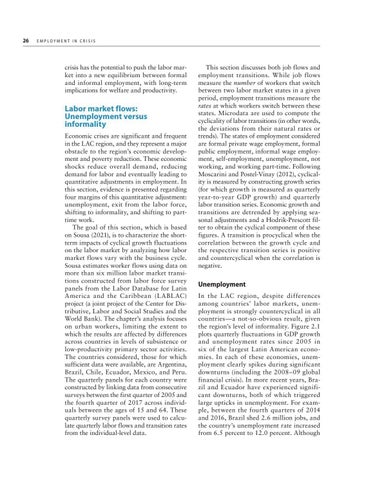26 E m p l o y m e n t
in Crisis
crisis has the potential to push the labor market into a new equilibrium between formal and informal employment, with long-term implications for welfare and productivity.
Labor market flows: Unemployment versus informality Economic crises are significant and frequent in the LAC region, and they represent a major obstacle to the region’s economic development and poverty reduction. These economic shocks reduce overall demand, reducing demand for labor and eventually leading to quantitative adjustments in employment. In this section, evidence is presented regarding four margins of this quantitative adjustment: unemployment, exit from the labor force, shifting to informality, and shifting to parttime work. The goal of this section, which is based on Sousa (2021), is to characterize the shortterm impacts of cyclical growth fluctuations on the labor market by analyzing how labor market flows vary with the business cycle. Sousa estimates worker flows using data on more than six million labor market transitions constructed from labor force survey panels from the Labor Database for Latin America and the Caribbean (LABLAC) project (a joint project of the Center for Distributive, Labor and Social Studies and the World Bank). The chapter’s analysis focuses on urban workers, limiting the extent to which the results are affected by differences across countries in levels of subsistence or low-productivity primary sector activities. The countries considered, those for which sufficient data were available, are Argentina, Brazil, Chile, Ecuador, Mexico, and Peru. The quarterly panels for each country were constructed by linking data from consecutive surveys between the first quarter of 2005 and the fourth quarter of 2017 across individuals between the ages of 15 and 64. These quarterly survey panels were used to calculate quarterly labor flows and transition rates from the individual-level data.
This section discusses both job flows and employment transitions. While job flows measure the number of workers that switch between two labor market states in a given period, employment transitions measure the rates at which workers switch between these states. Microdata are used to compute the cyclicality of labor transitions (in other words, the deviations from their natural rates or trends). The states of employment considered are formal private wage employment, formal public employment, informal wage employment, self-employment, unemployment, not working, and working part-time. Following Moscarini and Postel-Vinay (2012), cyclicality is measured by constructing growth series (for which growth is measured as quarterly year-to-year GDP growth) and quarterly labor transition series. Economic growth and transitions are detrended by applying seasonal adjustments and a Hodrik-Prescott filter to obtain the cyclical component of these figures. A transition is procyclical when the correlation between the growth cycle and the respective transition series is positive and countercyclical when the correlation is negative.
Unemployment In the LAC region, despite differences among countries’ labor markets, unemployment is strongly countercyclical in all countries—a not-so-obvious result, given the region’s level of informality. Figure 2.1 plots quarterly fluctuations in GDP growth and unemployment rates since 2005 in six of the largest Latin American economies. In each of these economies, unemployment clearly spikes during significant downturns (including the 2008–09 global financial crisis). In more recent years, Brazil and Ecuador have experienced significant downturns, both of which triggered large upticks in unemployment. For example, between the fourth quarters of 2014 and 2016, Brazil shed 2.6 million jobs, and the country’s unemployment rate increased from 6.5 percent to 12.0 percent. Although
